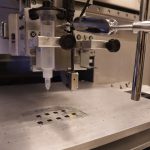U8. Micro – Nano Technology Unit
This Micro-Nano Technologies Unit is located in the Microelectronic Institute of Barcelona, (IMB-CNM, CSIC) and it is coordinated by Dr. Rosa Villa. The unit has the capacity for producing high quality CVD-graphene and, thanks to the integration of the unit in the clean room facilities of the IMB-CNM, it is possible to complete a wide range of micro- and nanofabrication processes (thermal processes and CVD, metallization, photolithography, dry and wet etching, etc.) for the complete fabrication of graphene-based microdevices. The unit also comprises the equipment that allow the fabrication of such devices in flexible substrates like Polyimide and Parylene to build biocompatible implants and neuroprosthesis. In addition, the unit has the capacity for the encapsulation and electrical characterization of the fabricated devices. The clean-room facility of the IMB-CNM is the largest installation with micro-nano technologies facilities in Spain. Its 1500 m2 Clean Room classes 10 to 10,000 are part of the MICRONANOFABS network, considered as Singular Scientific-Technical Infrastructure (ICTS). . FOR THOSE SERVICES IDENTIFIED AS OUTSTANDING, AT LEAST 20% OF THEIR CAPACITY IS OPEN UNDER COMPETITIVE ACCESS. SEE ANNEX 1 OF ACCESS PROTOCOL FOR DETAILS ON % OF OPENNESS FOR EACH SERVICE
. Furthermore, in the IMB-CNM clean room (1500 m², Classes 10 to 10,000), there is also the following equipment, which is accessible under its own access policy:
21 Oct Chips R’ Us, a pediatric respiratory infection study, wins CIBER’s Young Researcher Call, developing an innovative lung model using Organ-on-Chip technology. Vigo, october 2024. The project Chips R’ Us, focused on studying lower respiratory infections in pediatric patients, has been selected in the 2024 Call for Intramural Projects for Young Researchers of the Biomedical Research Networking Center (CIBER). An evaluation board composed of specialists from various CIBER thematic areas evaluated the proposals based on their novelty, feasibility, interdisciplinary collaboration, and potential social impact. Led by Dr. Gabriel Alfranca, a researcher in the area of Bioengineering, Biomaterials, and Nanomedicine (CIBER-BBN) at[...] 08 Mar Our interview series delve into the journeys of 7 female researchers, their challenges, and the call for gender equality in science, inspiring the next generation. March 8th 2024, NANBIOSIS (Spain) Kicking off on 11F “International Day of Women and Girls in Science” 2024, and spanning all the way until Woman’s Day 2024, our interview series has aimed to highlight the life, career and opinions of some of the brilliant minds within our network. Today is time to wrap it up, and for this reason we present you a summary of each of them and a chance to take a deeper[...] 18 Jul Scientists of NANBIOSIS Unit 8 have participated in the publication of a a comprehensive experimental review of inks, paper substrates, and printing techniques. The objective is to offer the scientific community a guide with data to facilitate the design of printed devices and manufacture them in an ecological way. Gemma Gabriel, researcher of Biomedical Applications Group at IMB-CNM and last author of the article, highlights the applications of the results in health monitoring, with non-invasive techniques such as glucose detection, although there are many applications where printed electronic materials and technologies are very useful. Among them, environmental monitoring, (in air[...] 03 Feb CIBER Centro de Investigación Biomédica en Red (Consortium for Biomedical Research Network), one of the ICTS NANBIOSIS nodes to which 18 of its 26 units belong, presents the new institutional video “CIBER is Collaboration” This video puts a face to the scientific activity of CIBER researchers and highlights CIBER capacity for synergy. CIBER researchers speak about the main research lines of its 13 subject areas and highlights the collaboration between its more than 500 groups and more than 6,000 researchers belonging to more than 100 institutions of different natures that make up CIBER: hospitals, research centers, universities, foundations, etc. T[...] 25 May Elisabet Prats Alfonso, a researcher in the team coordinating NANBIOSIS U8 Micro– Nano Technology Unit explains in a podcast her most recent research based on the functionalization of chemical and biochemical sensor platforms as well as the characterization of materials such as graphene for both neuronal recording and biomarker detection. Her work is part of the Graphene Flagship project in which she collaborates with relevant European groups. Eli Prat as a researcher Ph.D. in Chemistry and also dedicated to dissemination is a great exemple for the NANBIOSIS aim to encourage STEAM scientific vocations especially among girls. In addition, she is[...] 07 Apr In the Picture: Gemma Gabriel and Rosa Villa World Health Day is celebrated every year on 7 April (on the aniversary of the World Health Organization constitution) to raise awareness about the ongoing health issues that concern people across the world. This year, Xarctec Salud has called the attention on patients with brain diseases and spinal cord injuries and has highlighted the GAB Lab. Biomedical Applications Group of the IMB-CNM-CSIC and CIBER-BBN, the group, led by Rosa Villa, coordinates unit 8 ICTS NANBIOSIS of Micro-nano Technology Unit. https://youtu.be/wiA5oFc6Q48 The Xartec Salut is a network, led by CREB UPC, made up of 47[...] 07 Jan A study published in Nature Nanotechnology shows that flexible brain probes made of graphene micro-transistors can be used to record pathological brain signals associated with epilepsy with excellent fidelity and high spatial resolution. This research was led by the Institute of Microelectronics of Barcelona (IMB-CNM-CSIC), the Catalan Institute of Nanoscience and Nanotechnology (ICN2) and the University College London Queen Square Institute of Neurology (UK). The ability to record and map the full range of brain signals using electrophysiological probes will greatly advance our understanding of brain diseases and aid the clinical management of patients with diverse neurological disorders. However, current technologies[...] 23 Dec A study published in “Nature Nanotechnology” shows that flexible brain probes made of graphene micro-transistors can be used to record pathological brain signals associated with epilepsy with excellent fidelity and high spatial resolution. This research was led by the Catalan Institute of Nanoscience and Nanotechnology (ICN2), the Institute of Microelectronics of Barcelona (IMB-CNM-CSIC) and the University College London Queen Square Institute of Neurology (UK). Barcelona, Wednesday 22 December 2021. The ability to record and map the full range of brain signals using electrophysiological probes will greatly advance our understanding of brain diseases and aid the clinical management of patients wit[...]

U8. Micro – Nano Technology Unit


Description
Services
Equipments
Active projects
Title
Fundin: Organism
Call: Funding source
Role
GA: 696656

Graphene-based disruptive technologies — GrapheneCore1
Unión Europea (Comisión Europea)
H2020-Adhoc-2014-20
Partner
GA: 785219

Graphene Flagship Core Project-2 — GrapheneCore2’
’Unión Europea (Comisión Europea)
H202-SGA-FET-GRAPHENE-2017
Partner
GA: 649953

GRAPHENE FPA – FLAGSHIP - Graphene-based revolutions in ICT and beyond
Unión Europea (Comisión Europea)
H2020-FETFLAG-2014
Partner
SAF2017-90810-REDI

Strategic Promotion and coordinated management of Nanbiosis: Pronanbiosis II
Agencia Estatal de Investigación (AEI)
Acciones de dinamización «REDES DE EXCELENCIA»
-ICTS 2017Coordinator
Other projects
Ref
Title
Funding Organism
Unit Role
SAF2014-62114-EXP
RUPTURE OF THE HEMATORRETINIAN BARRIER: CAUSE OR CONSEQUENCE OF THE DIABETIC RETINOPATHY?
MINECO
Others
BIO2014-61377-EXP
BIOLIVER: THE DECONSTRUCTION APPLIED TO HEPATOLOGY
MINECO
Others
H2020-Adhoc-2014-20 - 696656
GrapheneCore1
European Commission
Participant
FP7-ICT-2013-FET-F - 604391
Neurographene: Neurological Recordings with Graphene
EUROPEAN COMISSION
Others
IMI Grant agreement No 115902
Remote Assessment of Disease and Relapse in Central Nervous System Disorders (RADAR-CNS)
Others
Publications
News U8

A project on pediatric respiratory infections, led by NANBIOSIS, wins the CIBER Young Researcher Call

The revolutionary path of research in NANBIOSIS and advice on Woman’s Day 2024

ICTS participation in the First guide to facilitate the sustainable design of printed electronic devices

“CIBER is collaboration”

“The almighty graphene”, a podcast by Elisabet Prats

Researchers of NANBIOSIS U8 highlighted in the World Health Day

New graphene-based neural probes improve detection of epileptic brain signals

The suitability of flexible graphene depth neuralprobes for in vivo electrophysiology research












